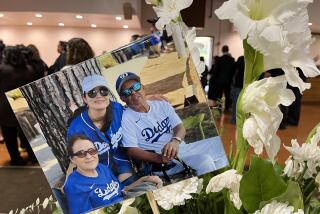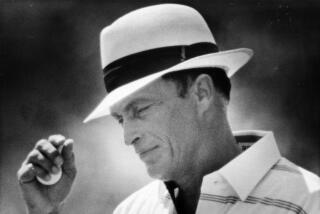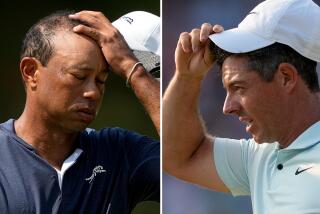Spurning the Spoils of Victory : Remaining an Amateur, Mickelson Keeps His Promise, Not the Cash
SAN DIEGO — You can’t miss Mom. She will be the one dressed in marshal’s togs and packing the “Quiet” sign while escorting her son from hole to hole next week in the Shearson Lehman Brothers Open.
It seems everyone wants a glimpse these days of Mary Mickelson’s wonderkid, Phil, the left-hander from Arizona State who won a PGA Tour event but couldn’t take the $180,000 in prize money because he is an amateur.
The galleries swell as the legend grows, and that’s a problem, because Mom would like to see her kid, too.
“I told Mary, ‘The good news is, your son is becoming very, very famous,’ ” said Dean Reinmuth, Phil’s longtime golf tutor. “ ‘And the bad news is, the more well-liked he becomes, the more you will be sitting in the clubhouse, watching TV to get the good viewpoint.’ ”
Next week, Mary’s son will come home as San Diego’s favorite son for the PGA exercise at Torrey Pines.
“He’s something special, all right,” said Steve Loy, coach of the NCAA champion Arizona State golf team. “As far as trying to teach him any more about the game, he’s beyond me. As far as how to handle people or deal with pressure, he’s beyond the athlete I coach at this level.
“He’s the only one of that ability I’ve ever coached. Time will tell if he may be the only one of that ability anyone ever gets to coach.”
Golf Digest took a close look at Mickelson through the eyes of the U.S. Golf Assn.’s P.J. Boatwright last November.
“I don’t believe I’ve ever seen anybody as good since (Jack) Nicklaus,” he said. “He is the best wedge player I’ve ever seen. And as a putter, this boy’s better than (Ben) Crenshaw.”
As good as . . . The best . . . Better than . . .
“I just want them to make sure he stays in school for two more years for the sake of our pocketbooks,” said pro Paul Azinger, after watching Mickelson become only the fourth amateur to win on the PGA Tour.
ASU senior co-captain Todd Kernaghan has seen Mickelson’s golfing imagination at work.
“He thinks he can hit any shot there is, and he can,” Kernaghan said. “That’s why I think he’s missing out on a real good opportunity. He’s past the college level. That’s obvious. Point blank, he’s already one of the best in the world. He’s not going to learn anything more in college golf. He’s out there with the big boys.”
Mickelson won’t turn 21 until June, but he has been replacing divots since he was 2. What more could an 11-year-old want after breaking 70?
Beating Dad.
“I figured there would come a time when he would beat me, but it came a little earlier than I thought,” said Mickelson’s father, also Phil. “He was around 11, and while he beat me, I didn’t figure to lose the first time by eight shots. I had an 81 and he shot a 73.”
The senior Mickelson says he never pushed his son toward the driving range or the putting green. It’s true he put a golf club in the youngster’s hands before he could walk, but it was a right-handed club. And he also put a baseball, a football, a basketball and a stuffed dog named Flopsie within easy reach.
The kid, however, latched onto the golf club. And Flopsie.
“Used to tuck them both next to him when he went to bed,” his father said.
By 7, it was apparent that young Phil never again would be intimidated by a water hazard. But Dad wasn’t ready to alert the media.
“I was playing with something like a seven-iron and nine and putter, and Dad said he’d buy me a full set of clubs if I won a trophy,” Mickelson recalled. “I said, ‘How can I win a trophy if I don’t have a full set of clubs?’
“But . . . I finished second in the San Diego Junior Golf Assn. 10-and-under tournament and got a trophy. I remember that best of anything because then I got my first set of clubs.”
Ladies clubs.
“It was a full set with all the numbers,” he said. “That’s all I knew . . . that’s all I cared about.”
Mom and Dad, meanwhile, were proud and supportive but not about to buy a home along a fairway.
They watched him play golf, and noticed at the same time that he had a knack for baseball. They thought for a while that he might pursue that, but then he turned down his selection to Little League all-stars because it cut into his time to play golf.
He played football, too, but in his eighth-grade season at Blessed Sacrament, he suffered a broken right arm. Surgery was required, and after a pin was put in his arm and it was covered by a cast, he went back to playing golf--one-handed.
“Look at how many people would really love to be a professional golfer,” Phil Sr. said. “Then take the percentage that are successful. No parent wants to guide their child into a profession with such a high failure rate. So we had no expectations.”
A high failure rate, indeed, especially for those who persist in hitting golf balls left-handed. There is only one left-handed player competing with exempt status on the PGA Tour: Russ Cochran.
The list of left-handers in golf history who have won major championships is equally long: Bob Charles, winner of the 1963 British Open.
Victory, however, has been as much a part of Mickelson’s career as the L-wedge in his golf bag. Last week he responded to more than 70 letters of congratulations for his first PGA Tour victory. He already has more victories and more honors than most any amateur in golf history:
* He was the junior player of the year when he was 15, and then again at 16. And 17.
* He is the only left-hander to have won the U.S. Amateur championship, and in the tournament’s 90-year history, Mickelson’s 64 last year is a record.
* He became the first player since Nicklaus to win the Amateur and NCAA championships in the same year.
* He has competed for the NCAA championship twice, and won it twice.
* He won the Haskins Award, the Heisman Trophy of college golf, and will be honored later this month as one of the San Diego Hall of Champions stars of the year.
And to think Dad tried to make him play golf right-handed. Tried again and again.
“And when he wasn’t looking, I’d switch back,” young Phil said.
Phil Mickelson is right-handed. He writes, he throws, he does most everything else right-handed. But when his father showed him early on how to swing a golf club, he accepted his father’s mirror image as the gospel golf swing.
“I told Phil, ‘The best thing you have going for you right now, other than playing well, is that you have an inborn marketing image,’ ” Reinmuth said. “ ‘Everybody knows who you are. At first, you will be that left-handed kid, and then in time they will know the name.’ ”
Probably in no time at all. After competing in San Diego, he will play in the Doral Open later this month, the Masters, Nicklaus’ Memorial tournament in May, and the British and U.S. opens next summer.
No amateur has won two PGA Tour events but Mickelson, who is nicknamed “Roman” by his teammates for his imperial dominance on the course, will have ample opportunity.
“Some guys dedicate their lives to winning a professional event,” ASU teammate Rob Mangini said. “He wins at age 20 and turns down the money.”
By winning the Amateur, he earned the opportunity to be paired with defending champion Hale Irwin in the U.S. Open. And in April, he will play the first two rounds of the Masters with Nick Faldo.
“I’m intrigued by Bobby Jones, and playing in his tournament (the Masters) as the amateur champion is going to be a neat experience,” Mickelson said. “I admire his style of play, his philosophy of the golf swing.
“He thought of the golf swing as a sequence of motion rather than a series of positions. It’s something I have never heard explained that way except from my teacher, Dean Reinmuth, and from what I’ve read of Bobby Jones.”
All comparisons of Mickelson to Bobby Jones, however, are quickly squelched.
“No, no, no,” Mickelson insisted. “Bobby Jones is obviously the greatest amateur to ever play. There will never be another Bobby Jones.
“I’m just a college kid. Twenty years old. I’m just trying to get through school. No big deal.”
You have a better chance of out-driving Phil Mickelson than getting him to acknowledge his accomplishments.
“We went skiing one time when he was younger, and Philip was standing in line next to this guy,” Mary said. “It seems this guy was really a terrific skier and Philip asked if he could go to the top of the mountain and watch him.
“When we got there later, Philip was still at the top. He said, ‘Mom, that man can’t ski. He just talks like he can ski.’
“Every once in a while when Philip would sound like he was tending to get a big head, we’d just look at him, and say, ‘Philip, do you remember that skier?’ Even to this day . . .”
It’s that foundation, said Loy, that time well spent with his parents and Reinmuth, that distinguishes Mickelson.
“From Day 1, before he ever won a thing, the best thing about Phil was the person he was,” Loy said. “I thank God every day I’ve had the opportunity to share in his life.”
It’s like Phil Sr. said, “He doesn’t have to win for us to be proud of him.”
He’s just “plain old ordinary Phil,” Mary said. “When he comes home he cleans his room and mows the lawn. He’s just our son. We go to tournaments and we see people asking for his autograph, and it’s like, ‘Why would they want his autograph?’ ”
Reporters want his time. The phone rings so much at his ASU apartment that roommate Scott Sullivan no longer answers it.
“If they want him bad enough, they’ll find him,” he said.
They do, too, and Mickelson is ready for them. Ever-obliging, he understands what to say, how to say it, and what kind of impact it will have. As with his golf game, there are no errant shots.
“You know, Philip was what you would call a strong-willed child,” Mary said. “He always knew what he wanted. He learned to get it by talking. We might tell him to be home by 11 and he’d outline everything like an attorney and make so much sense that we’d end up agreeing with him.
“I’d go to the parent-teacher conferences at school and his teacher would tell me that Philip would come up to her, put an arm around her and say, ‘You are my very favorite teacher.’ I’d go to the next class, and the teacher would say, ‘Now I suppose you know I’m Phil’s very favorite teacher.’ ”
Such aplomb translates into his aggressive play from tee to green. There is, seemingly, no nervousness.
“It was interesting playing with Nicklaus,” he will tell you. “And no, no butterflies.
“The most nervous I have ever been was trying to dunk a basketball in front of 20,000 people at a Phoenix Suns game.”
Mickelson had played in the third round of the Phoenix Open, and then was going to be honored that night at the game. He was pulled out of the crowd by the Suns’ mascot, the Gorilla, and found a basketball shoved into his stomach.
“I found out later I was supposed to give the ball back to the Gorilla,” he said, but once a competitor . . .
Mickelson took the ball, ran and jumped on a trampoline with the intention of dunking the ball. He caught himself, though, hit the ground and settled for a conventional layup.
There will be no such pause for caution next week at Torrey Pines.
“When we started, we actually believed he could win a tour event,” Loy said. “He had one of three opportunities initially. He had played before in Tucson, knew the Phoenix course as well as anyone and has the hometown environment in San Diego.
“Winning was in his picture, and I’ll tell you right now, it ain’t over.”
It’s only beginning. He posted a winning 271, 16 under par, in the Tucson Open in early January, but since he had designated himself an amateur, he could not accept the first-place prize of $180,000. He also had to pass on the $5,414 paid to each of the seven players who tied him for 32nd place in the Phoenix Open two weeks ago.
“I don’t think the money is that important to him right now,” Mary said. “We give him a little bit each month. It’s not much, but enough for his gas and maybe for going to a movie. He probably doesn’t have the car he wants or the clothes, but I think it’s good for him to be in the position where he wants things and has to work for them.”
But that’s $185,414 . . .
“It’s nice to think about,” Mickelson said. “But that’s all. There’s things I want to accomplish in life that have nothing to do with money. I want to win because I enjoy competition and want to be successful.
“If it was a job, I would be a pro trying to make money. But I don’t play for money. I never got paid before and played, and since I don’t need money, there’s no pull to turn pro.”
But $185,414 . . .
“I’m going to finish school probably,” he said. “I don’t think getting a degree is all that important. Finishing my commitment is. It’s part of my agreement (for a scholarship). It’s also the thought of quitting school; just that quitting word.”
After his victory in Tucson, Mickelson returned to Tempe and his homework. Despite his preoccupation with golf as a youngster, Mickelson was an honor student at University of San Diego High.
He has continued to apply himself at ASU, although his demanding athletic schedule has made it increasingly difficult. Classes begin each day for the junior sports psychology major with Todd Borgwald’s Spanish class at 7:40 a.m.
“I didn’t know who Phil was until one day I saw his picture in the paper,” Borgwald said. “Phil’s a damn bright guy. Last semester I also had him in my class and out of 65 students, he had the fourth-highest grade.”
Tana Figueras, who has been best friend, girlfriend and caddie for Mickelson, also takes the Spanish class with him.
“He’s in a little bubble right now, and he can break it any time he wants,” said Figueras, who went to high school with Mickelson. “He’s very protected (at ASU), but he has the opportunity to go out. I don’t. If I went out I’d have to be a waitress or something. I have to stay in school.
“But he can have guaranteed fame. That’s scary to think about. There’s so much involved, so many things happening for him right now.”
If Mickelson wanted, Reinmuth said, he could turn pro today. There will be no need to beg for sponsors. It’s all there, ready to happen for Mickelson when he says it’s time.
But at 3:30 in the afternoon, it was time for Mickelson, the amateur, to join his ASU teammates for practice on the school’s Karsten Golf Course. There wasn’t a tree within a three-wood of the driving range, and the noise from Rural Road wouldn’t quit, but out there with his fellow Sun Devils, Mickelson was at peace.
“Who’s this?” Mickelson said, taking a mighty slash at the ball before walking off and slinging the club back over his shoulder.
“Stadler,” said sophomore Cade Stone, and his correct guess sent Mickelson’s imagination racing.
“Oh, oh, oh, now how about this one?” Mickelson said, swatting the ball and cranking his head from side to side as he watched it disappear into the distance. “Come on, you know.”
Well, it has been awhile since Arnold Palmer was in the spotlight.
“OK, get a load of this,” Mickelson said. A crowd had gathered.
“Look, look,” he said, and the swing that probably will earn millions one day was being put to torture. The elbow went flying on the looping backswing, and on contact, the ball rolled but inches off the tee.
The laughter was louder than the passing cars. He tried again, and while it wasn’t all quite there, Larry Barber recognized the exaggerated windmill: It was that of his father, Miller.
“You all are imitating people and I’m trying to find my golf swing,” Barber said in mock irritation, before giving the group a first-rate Lee Trevino.
Mickelson fired back with a perfect Hubert Green.
“Look at him messing around,” teammate Mangini said. “He’s just one of the guys.”
But with the passing of a few more fine Arizona afternoons, how long will it be before some youngster somewhere flips up his collar, jumps to the opposite side of the ball and asks, “Now who’s this?”
More to Read
Go beyond the scoreboard
Get the latest on L.A.'s teams in the daily Sports Report newsletter.
You may occasionally receive promotional content from the Los Angeles Times.










